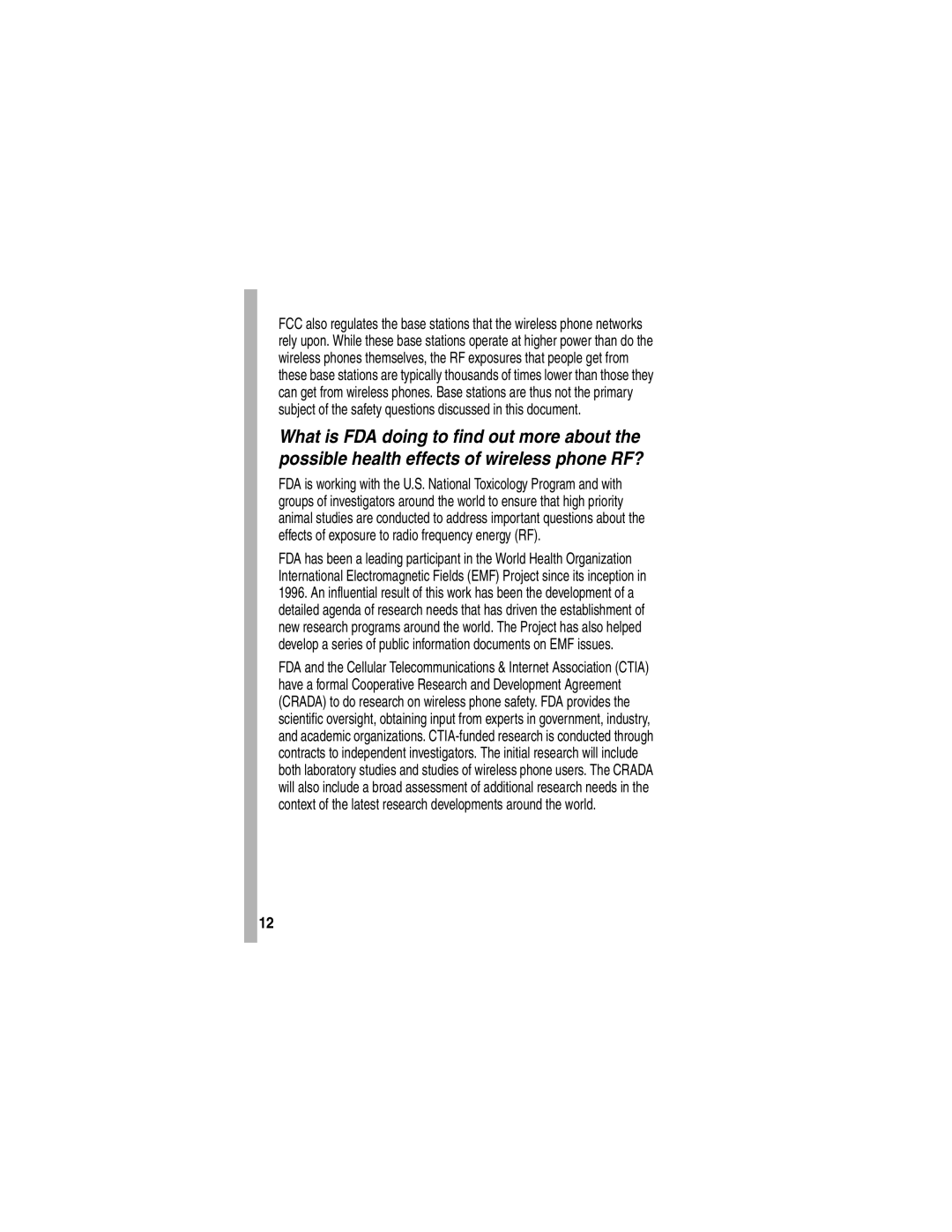Start Here
Page
Welcome
Check It Out
Picture ID
Wireless
Set Photo as
Send
Motorola, Inc
Manual number 6809467A24-A
Contents
Page
Page
About This Guide
Getting Started
Or contact the Motorola Customer Call Center at
Optional Accessories
Installing the SIM Card
Optional Features
Provider for more information
Battery Use
To maximize your battery’s performance
Installing the Battery
Charging the Battery
Plug the travel
Turning Your Phone On
Turn off an incoming call alert
Adjusting Volume
Making a Call
Keypad keys Dial the phone number Make the call
Viewing Your Phone Number
Answering a Call
Nor Answer the call
Find the Feature M Multimedia Camera
Highlight Features
Taking and Sending a Photo
View storage options
Point the camera lens at the photo subject, then
Take a photo
Active viewfinder
Find the Feature
Sending a Multimedia Message
To add another slide to
Contents for the new slide
Insert the file
To send the message, go to
Receiving a Multimedia Message
To play a video clip stored on your phone
Find the Feature M Multimedia Videos
Playing Video Clips
Scroll to the video clip
Using a Bluetooth Wireless Connection
Scroll to the light pattern
Using Ring Lights
Select the light pattern
To turn event lights on or off
Using Event Lights
Changing Phone Covers
Scroll to On or Off
Close the phone flip
Removing a Flip Cover
Attaching a Flip Cover
Slide the cover onto the phone until it snaps into place
Learning to Use Your Phone
Using the Display
See page 1 for a basic phone diagram
Date
Strength
Battery
Presence
Level
CSD call
= secure packet
Call
Context active
= 2G home = 2G roam
= alarm activated
= 2.5G home
= line 1 active
= silent
Session
= location on
Using the 5-Way Navigation Key
Way Navigation Key
Using Menus
End Key
Selecting a Menu Feature
Find the Feature M Recent Calls Dialed Calls
Selecting a Feature Option
Entering Text
Setting Up a Text Entry Method
Choosing a Text Entry Method
Using Capitalization
Using Tap Method
Text Entry Method Indicators
Store the text
Store text
After
Press Sright to accept
Tap Method Text Entry Rules
Character Chart
? ! , @ & ~
Press Sright to highlight
Using iTAP Method
Words
Press *to enter Prog and a space
Entering Words
Keypad keys Show possible symbol One press per
Using Numeric Method
Using Symbol Method
Symbol Display Sleft or right
Symbol Chart
Deleting Letters and Words
Setting Phone Ring Style
Using Smart Key
Using the External Display
Soft key +
Volume keys Scroll to Forward Smart key
Using the Handsfree Speaker
Adjusting Voice Call Forwarding
Volume keys Return to the home screen
Changing a Code, PIN, or Password
Locking Your Phone Manually
Locking and Unlocking Your Phone
Unlocking Your Phone
If You Forget a Code, PIN, or Password
Setting Your Phone to Lock Automatically
Recording a Voice Name
Using the Phonebook
Storing a Phone Number
Dialing a Number
Voice Dialing a Number
Setting a Picture ID for a Phonebook Entry
Setting Picture ID View
Sorting Phonebook Entries
Storing Your Name and Phone Number
Setting Up Your Phone
Setting the Time and Date
You must set the time and date to use the datebook
Scroll to the ring style
Setting a Ring Style
Select the ring style
To activate or deactivate an answer option
Setting Answer Options
Confirm the setting
Scroll to Multi-Keyor
Setting a Wallpaper Image
Select the image Scroll to Delay
Setting a Screen Saver Image
Set the delay interval
Save screen saver settings
Adjusting the Backlight
Setting Display Brightness
Setting Display Color
Setting Display Timeout
Redialing a Number
Calling Features
Changing the Active Line
View the dialed calls list
Incoming Calls
Using Automatic Redial
Using Caller ID
To redial the phone number
Calling an Emergency Number
Turning Off a Call Alert
Outgoing Calls
Viewing Recent Calls
Dialing International Numbers
Select the list
Call the entry’s number
Scroll to an entry
Connected
Tip Press and hold Nfor
Returning an Unanswered Call
Using the Notepad
Attaching a Number
Calling With Speed Dial
Using Voicemail
Calling With 1-Touch Dial
Receiving a Voicemail Message
Listening to Voicemail Messages
Storing Your Voicemail Number
Answer the new call
Using Call Waiting
Switch between calls
Connect the 2 calls
Transferring a Call
Putting a Call On Hold
Announce the Call Transfer
Do Not Announce the Call Transfer
Phone Features
Main Menu
Settings Menu
Initial Setup
Feature Quick Reference
Calling Features
Messages
Instant Messaging
Chat
Phonebook
Set
Set Picture
ID View
Category
Phonebook
Light ID
Sort
List
Personalizing Features
Menu Features
Dialing Features
Call Monitoring
Tones
Handsfree Features
Data and Fax Calls
Bluetooth Wireless Connections
Network Features
Personal Organizer Features
Voice
Alarm
Turn Off
Record
Security
News and Entertainment
Computer
Theme
Game or
Manage
With
Video Clips
Edit Sounds
MotoMixer
Specific Absorption Rate Data
Page
Index
Call waiting Caller ID 3, 18, 52, 60, 63
Event lights 3, 25 external display
Instant messaging. See IM international access code
Screen 81 icons, converting to text
Numbers, entering Touch dial Setting preference 79 using
Optional feature, defined Passwords. See codes phone
Redialing
100
Soft keys functions 28, 33 illustration
Ring lights 3
SIM PIN code changing 48 entering SIM PIN2 code, changing
101
Speed dial
102
Patent Re ,976
103
104
Important Safety and Legal Information
Software Copyright Notice
Part Number 6809476A21-O
Contents
Safety and General Information
External Antenna Care
Body-Worn Operation
Approved Accessories
Phone Operation
Data Operation
Aircraft
Facilities
Medical Devices
For Vehicles With an Air Bag
Potentially Explosive Atmospheres
Batteries
Blasting Caps and Areas
Chargers
Repetitive Motion Injuries
FDA Consumer Information on Wireless Phones
National Telecommunications and Information Administration
Page
What about children using wireless phones?
Page
Motorola Limited Warranty for the United States and Canada
Products and Accessories
Exclusions
Software
Date of purchase
Two-Way Radios and Messaging Devices
Page
Online Product Registration
Thank you for choosing a Motorola product
Wireless The New Recyclable
Page
Wireless Phone Safety Tips
Safety is your most important call
Page
Wherever wireless phone service is available
Page
Page
Motorola.com
